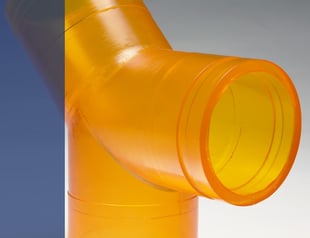Polyurethanes for Energy Applications
Polyurethanes are more than just a foam cushion or soles at the bottom of shoes. They are versatile materials that can provide advanced solutions for both onshore and offshore applications. With their unique ability to be tailored to meet specific physical properties, polyurethanes have become a go-to material over traditional materials. In this post, we will take a closer look at polyurethanes and how they can improve product performance in energy applications.

What is Polyurethane?
Polyurethanes are created by a chemical reaction between polyols and isocyanates. Despite having a complex chemical structure, thermoset polyurethanes can offer a wide range of customizable materials and manufacturing processes to meet specific design and performance requirements. This versatility enables polyurethanes to be molded into different shapes, sizes, and forms, with superior physical properties that make them resistant to extreme temperatures, abrasion, and chemicals, among others. To learn more about the physical properties of polyurethanes, click here.
Polyurethanes Compared to Other Materials
When compared to traditional materials like metal and rubber, polyurethane offers several advantages in energy applications like oil & gas, electricity generation, and renewables. For starters, it has a lower density than metal, making it a lightweight option. Additionally, they are highly resistant to abrasion and extreme temperatures, providing longevity and durability in harsh environments. For example, thermoset polyurethane is commonly used for slurry pipelines as it can resist wear and corrosion. Metal and rubber, on the other hand, typically cannot withstand the same level of wear and tear in these harsh environments, resulting in frequent repairs and replacements.
To further showcase the benefits of thermoset polyurethanes in energy applications, here is another example:
Durastatic Pipe
 The Problem: An oil & gas company in the western region of the United States was experiencing frequent failures with the steel pipe systems due to wear and tear caused by harsh operating conditions. The company needed a solution that could withstand extreme temperatures, high abrasion, and corrosion while ensuring a reliable transport of fluids.
The Problem: An oil & gas company in the western region of the United States was experiencing frequent failures with the steel pipe systems due to wear and tear caused by harsh operating conditions. The company needed a solution that could withstand extreme temperatures, high abrasion, and corrosion while ensuring a reliable transport of fluids.
The Solution: MPC proposed the Durastatic anti-static pipe system, made from specially formulated materials that offer superior strength, durability, and resistance to wear, abrasion, and corrosion. The system's seamless design also minimizes the risks of leaks that can compromise safety during the transport of fluids.
The Result: The oil & gas company deployed MPC's Durastatic pipe system and saw a significant reduction in maintenance costs and downtime. The Durastatic pipe system proved to be durable and reliable, withstanding the harsh operating conditions - exceeding customer expectations.
In conclusion, thermoset polyurethanes have proven to be a versatile material in several energy applications, providing superior performance and durability compared to traditional materials. If you are seeking material assistance for your critical product design, complete our design tool, here, or download our material data sheet below:




